vol. 32, No. 8, 2021, p. 1499-1686
Determining the exact tree-dimensional structure of chiral secondary metabolites may be a puzzling process. As a result, a number of incorrect stereochemical assignments have been reported over the last ten years. This review brings a summary of recent absolute configuration reassignments of natural products and presents guidance on selecting the right pieces to solve structural puzzles. Details are presented in the Review Absolute Configuration Reassignment of Natural Products: An Overview of the Last Decade by Andrea N. L. Batista, Bianca R. P. Angrisani, Maria Emanuelle D. Lima, Stephanie M. P. da Silva, Vitória H. Schettini, Higor A. Chagas, Fernando M. dos Santos Jr., João M. Batista Jr. and Alessandra L. Valverde on page 1499.
Absolute Configuration Reassignment of Natural Products: An Overview of the Last Decade
Andrea N. L. Batista  ; Bianca R. P. Angrisani; Maria Emanuelle D. Lima; Stephanie M. P. da Silva; Vitória H. Schettini
; Bianca R. P. Angrisani; Maria Emanuelle D. Lima; Stephanie M. P. da Silva; Vitória H. Schettini  ; Higor A. Chagas; Fernando M. dos Santos Jr.; João M. Batista Jr.
; Higor A. Chagas; Fernando M. dos Santos Jr.; João M. Batista Jr.  ; Alessandra L. Valverde
; Alessandra L. Valverde
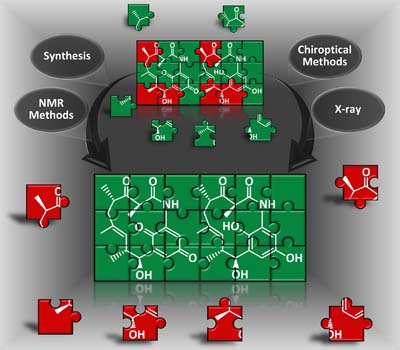
Determining the exact tree-dimensional structure of chiral secondary metabolites may be a puzzling process. As a result, a number of incorrect stereochemical assignments have been reported over the last ten years. This review brings a summary of recent absolute configuration reassignments of natural products and presents guidance on selecting the right pieces to solve structural puzzles. Details are presented in the Review Absolute Configuration Reassignment of Natural Products: An Overview of the Last Decade by Andrea N. L. Batista, Bianca R. P. Angrisani, Maria Emanuelle D. Lima, Stephanie M. P. da Silva, Vitória H. Schettini, Higor A. Chagas, Fernando M. dos Santos Jr., João M. Batista Jr. and Alessandra L. Valverde on page 1499.
https://dx.doi.org/10.21577/0103-5053.20210079
Review J. Braz. Chem. Soc. 2021, 32(8), 1499-1518
Absolute Configuration Reassignment of Natural Products: An Overview of the Last Decade
Andrea N. L. Batista  ; Bianca R. P. Angrisani; Maria Emanuelle D. Lima; Stephanie M. P. da Silva; Vitória H. Schettini
; Bianca R. P. Angrisani; Maria Emanuelle D. Lima; Stephanie M. P. da Silva; Vitória H. Schettini  ; Higor A. Chagas; Fernando M. dos Santos Jr.; João M. Batista Jr.
; Higor A. Chagas; Fernando M. dos Santos Jr.; João M. Batista Jr.  ; Alessandra L. Valverde
; Alessandra L. Valverde
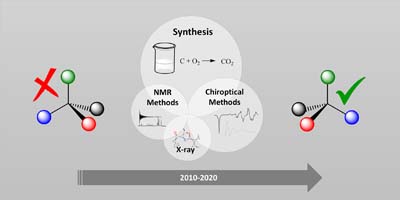
This review highlights the increase in the number of absolute configuration reassignments of natural products over the last decade and describes the main approaches used both in the original incorrect assignments and stereochemical corrections. It also provides the readers with critical information for the choice of appropriate methods for unambiguous stereochemical determination.
https://dx.doi.org/10.21577/0103-5053.20210079
Articles J. Braz. Chem. Soc. 2021, 32(8), 1519-1530
Complexes with Furyl-Substituted 3-Hydroxychromone: Synthesis, Characterization and Fluorescence Studies
Mariana Leticia M. Camargo; Fábio A. dos Santos  ; Lucas Pizzuti
; Lucas Pizzuti  ; Ulrich Abram
; Ulrich Abram  ; Vânia Denise Schwade
; Vânia Denise Schwade
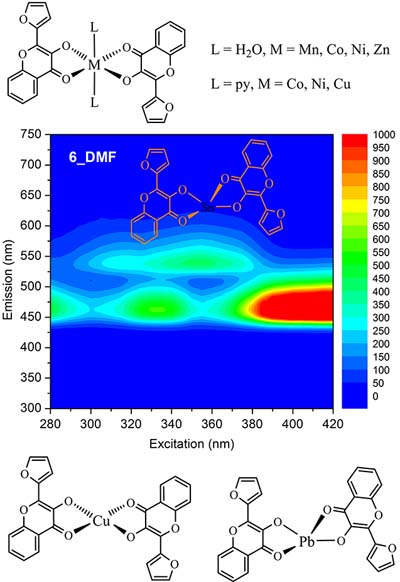
The furyl-substituted 3-hydroxychromone ligand forms stable complexes with MII ions. Complex [Sn(L)2] represents the first structurally characterized SnII complex with this kind of ligand and presented high fluorescence emission.
https://dx.doi.org/10.21577/0103-5053.20210049
J. Braz. Chem. Soc. 2021, 32(8), 1531-1540
A Comparison of the Photolytic and Photocatalytic Degradation of Triclosan: Identification of Transformation Products and Ecotoxicity Evaluation
Vitor S. Kosera; Elisabeth C. Lumbaque  ; Alexsandro Dallegrave; Monike F. Gomes; Vinícius C. S. de Paula; Adriane M. de Freitas; Carla Sirtori; Eduardo S. Chaves; Elaine R. L. Tiburtius
; Alexsandro Dallegrave; Monike F. Gomes; Vinícius C. S. de Paula; Adriane M. de Freitas; Carla Sirtori; Eduardo S. Chaves; Elaine R. L. Tiburtius
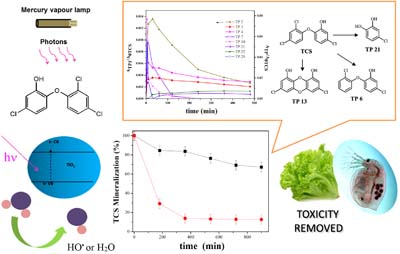
Heterogeneous photocatalysis and photolysis were employed to degrade triclosan (5-chloro-2-(2,4-dichlorophenoxy)phenol) with evaluation of ecotoxicity. The degradation was associated with the formation of transformation products whose structures are reported for the first time.
https://dx.doi.org/10.21577/0103-5053.20210050
J. Braz. Chem. Soc. 2021, 32(8), 1541-1551
Elemental Chalcogen (Se, S) in PEG-400 to the Synthesis of Seleno- and Thioflavones from
2-Chlorophenyl Ethynyl Ketone and Nucleophilic Species of Chalcogen
Patrick C. Nobre; Thiago J. Peglow; Ricardo H. Bartz; Angelita M. Barcellos  ; Raquel G. Jacob; Márcio S. Silva; Thiago Barcellos
; Raquel G. Jacob; Márcio S. Silva; Thiago Barcellos  ; Gelson Perin
; Gelson Perin
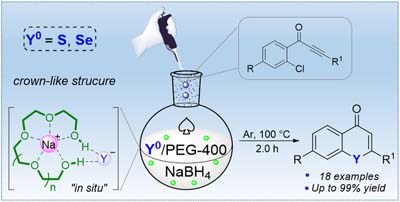
The polyethylene glycol-400 (PEG-400) acts like a crown ether, making the NaHY more active to prepare chalcogenflavones by the ring closure of 2-chlorophenyl ethynyl ketone.
https://dx.doi.org/10.21577/0103-5053.20210051
J. Braz. Chem. Soc. 2021, 32(8), 1552-1558
Green Synthesis of Upconverting NaYF4 and NaGdF4 Materials and Energy Levels Determination
Luidgi Giordano  ; Matheus F. Nunes; Verônica C. Teixeira
; Matheus F. Nunes; Verônica C. Teixeira  ; Lucas C. V. Rodrigues
; Lucas C. V. Rodrigues
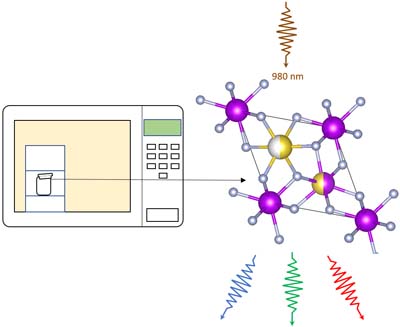
Fast and energy-saving synthesis developed for multicolor upconverting materials.
https://dx.doi.org/10.21577/0103-5053.20210052
J. Braz. Chem. Soc. 2021, 32(8), 1559-1567
Stability Analyses by HPLC-MS of Guanitoxin Isolated from Sphaerospermopsis torques-reginae
Kelly A. Fernandes  ; Felipe Augusto Dörr; Ernani Pinto
; Felipe Augusto Dörr; Ernani Pinto

Guanitoxin is a potent cyanotoxin that can be hydrolyzed gradually at alkaline pH and temperatures > 23 °C, resulting in the dephosphorylated degradation product m/z 159.1240 [M + H]+.
https://dx.doi.org/10.21577/0103-5053.20210053
J. Braz. Chem. Soc. 2021, 32(8), 1568-1574
Multivariate Optimization Applied to the Synthesis of Meglumine Antimoniate with Low Levels of Trivalent Antimony
Henrique J. F. Fabrino; Frédéric J. G. Frezard; Ana Carolina B. de Oliveira; Letícia M. Costa; Cynthia P. Demicheli

Multivariate optimization was used in the meglumine antimoniate synthesis in order to obtain a drug with low levels of SbIII and consequently reduce side effects and development of drug resistance.
https://dx.doi.org/10.21577/0103-5053.20210054
J. Braz. Chem. Soc. 2021, 32(8), 1575-1583
Ketones as Electrophile in Nitroaldol Reaction: Synthesis of β,β-Disubstituted-1,3‑dinitroalkanes and Allylic Nitro Compounds
Alex O. Gomes  ; Douglas L. F. de Souza; Jeronimo S. Costa; Vera Lúcia P. Pereira
; Douglas L. F. de Souza; Jeronimo S. Costa; Vera Lúcia P. Pereira
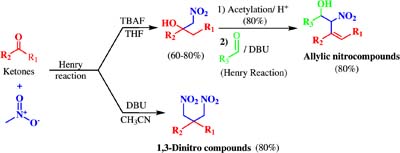
β,β-Disubstituted-1,3-dinitrocompounds were obtained in "one pot" via addition of nitromethane to different ketones using DBU (1,8-diazabicyclo[5.4.0]undec-7-ene) 50%, as base. Additionally, allylic nitro compounds could be obtained via a sequence Henry reaction, acetylation acid catalyzed and subsequent Henry reaction with varied aldehydes.
https://dx.doi.org/10.21577/0103-5053.20210055
J. Braz. Chem. Soc. 2021, 32(8), 1584-1597
Methanolic Extract of Rhinella marina Poison: Chemical Composition, Antioxidant and Immunomodulatory Activities
Sheila R. N. Pelissari; Valéria D. G. Sinhorin  ; Lindsey Castoldi; Leonardo G. de Vasconcelos; Domingos J. Rodrigues; Eloana B. S. Ribeiro; Jacqueline Kerkhoff
; Lindsey Castoldi; Leonardo G. de Vasconcelos; Domingos J. Rodrigues; Eloana B. S. Ribeiro; Jacqueline Kerkhoff  ; Adilson P. Sinhorin
; Adilson P. Sinhorin
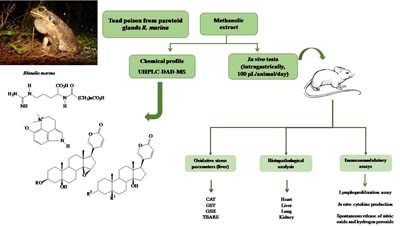
The poison extracted from the frog had its chemical composition identified. Male Swiss mice treated with methanolic poison extract were evaluated for oxidative stress, immunomodulatory action and the histopathological effects of the treatment during 7 or 30 days.
https://dx.doi.org/10.21577/0103-5053.20210057
J. Braz. Chem. Soc. 2021, 32(8), 1598-1606
Preparation of SAPO-34-Based Catalyst for Conversion of Fructose to 5-Hydroxymethylfurfural
Yangyang Zhang  ; Chuan Shao; Dongling Qin; Gang Yang
; Chuan Shao; Dongling Qin; Gang Yang
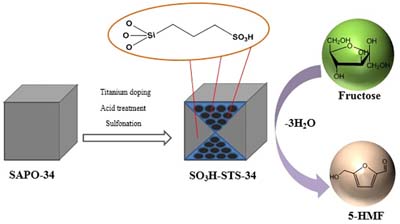
SAPO-34 molecular sieve was modified to develop a catalyst for the preparation of 5-hydroxymethylfurfural (5-HMF) from fructose dehydration.
https://dx.doi.org/10.21577/0103-5053.20210058
J. Braz. Chem. Soc. 2021, 32(8), 1607-1616
Agro-Industrial Waste Valorization: Transformation of Starch from Mango Kernel into Biocompatible, Thermoresponsive and High Swelling Nanogels
Marlizia A. L. de Oliveira; Liszt Y. C. Madruga  ; Bruna L. B. de Lima; Marcos A. Villetti; Men S. M. de Souza Filho; Matt J. Kipper; Nívia N. Marques; Rosangela C. Balaban
; Bruna L. B. de Lima; Marcos A. Villetti; Men S. M. de Souza Filho; Matt J. Kipper; Nívia N. Marques; Rosangela C. Balaban
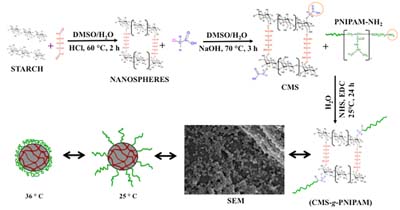
Starch from mango kernel was turned into swelling thermoresponsive nanoparticles with suitability for cell- and blood-contacting applications.
https://dx.doi.org/10.21577/0103-5053.20210059
J. Braz. Chem. Soc. 2021, 32(8), 1617-1627
Integrated UPLC-HRMS, Chemometric Tools, and Metabolomic Analysis of Forage Palm (Opuntia spp. and Nopalea spp.) to Define Biomarkers Associated with Non-Susceptibility to Carmine Cochineal (Dactylopius opuntiae)
Thiago Kelvin B. Matos  ; Jhonyson A. C. Guedes
; Jhonyson A. C. Guedes  ; Elenilson G. Alves Filho
; Elenilson G. Alves Filho  ; Licia R. Luz; Gisele Simone Lopes
; Licia R. Luz; Gisele Simone Lopes  ; Ronaldo F. do Nascimento; João A. de Sousa; Kirley M. Canuto; Edy S. de Brito; Nivia S. Dias-Pini; Guilherme J. Zocolo
; Ronaldo F. do Nascimento; João A. de Sousa; Kirley M. Canuto; Edy S. de Brito; Nivia S. Dias-Pini; Guilherme J. Zocolo
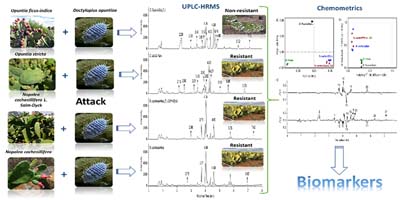
Chemical identification and determination of forage palm biomarkers (Opuntia spp. and Nopalea spp.) associated with non-susceptibility to carmine cochineal.
https://dx.doi.org/10.21577/0103-5053.20210060
J. Braz. Chem. Soc. 2021, 32(8), 1628-1641
DFT, Molecular Docking, and ADME/Tox Screening Investigations of Market‑Available Drugs against SARS‑CoV‑2
Joabe L. Araújo  ; Lucas A. de Sousa; Alice O. Sousa
; Lucas A. de Sousa; Alice O. Sousa  ; Ruan S. Bastos; Gardênia T. Santos; Mateus R. Lage; Stanislav R. Stoyanov; Ionara N. G. Passos; Ricardo B. de Azevedo; Jefferson A. Rocha
; Ruan S. Bastos; Gardênia T. Santos; Mateus R. Lage; Stanislav R. Stoyanov; Ionara N. G. Passos; Ricardo B. de Azevedo; Jefferson A. Rocha
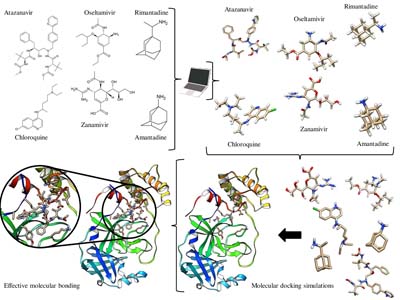
The molecular geometries of target drugs in 2D optimized by calculations of the density functional theory are subjected to investigations of their molecular properties and molecular docking simulations.
https://dx.doi.org/10.21577/0103-5053.20210061
J. Braz. Chem. Soc. 2021, 32(8), 1642-1653
Dextran Sulfate/Pramlintide Polyelectrolyte Nanoparticles as a Promising Delivery System: Optimization, Evaluation of Supramolecular Interactions and Effect on Conformational Stability of the Peptide Drug
Carine Zuglianello  ; Andrés F. Chamorro; Vanessa A. de Oliveira; Francisco H. Xavier Júnior; Elenara Lemos-Senna
; Andrés F. Chamorro; Vanessa A. de Oliveira; Francisco H. Xavier Júnior; Elenara Lemos-Senna
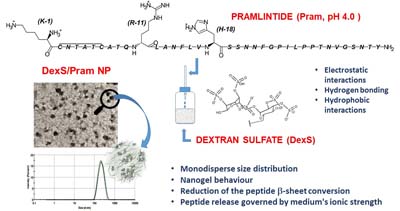
DexS/Pram (dextran sulfate/pramlintide) polyelectrolyte nanoparticles were successfully developed. Interestingly, self-assembling reduces the peptide conversion to β-sheet conformation. Colloidal stability and Pram release are depending on the ionic strength of the medium.
https://dx.doi.org/10.21577/0103-5053.20210062
J. Braz. Chem. Soc. 2021, 32(8), 1654-1669
Synergy between Experimental and Theoretical Investigations Reveals the Anti‑Corrosion Efficiency of Imine-Chalcones
Mariana P. Carlos; Neubi F. Xavier Jr.; Antônio M. da Silva Jr.; Marcelo A. Neves; Aurea Echevarria  ; Glauco F. Bauerfeldt
; Glauco F. Bauerfeldt
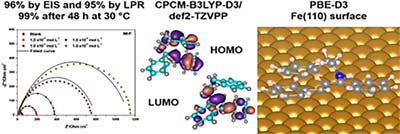
Anticorrosive effect of imine-chalcone (IM-F) on carbon steel in 1 mol L-1 HCl using experimental methods and theoretical calculations.
https://dx.doi.org/10.21577/0103-5053.20210063
J. Braz. Chem. Soc. 2021, 32(8), 1670-1679
Polyphenol Profile and Quantitative Assessment of the Flavonoid Kaempferitrin in Wild and Cultivated Brazilian Amazonian Uncaria guianensis (Rubiaceae)
Djavan da Paixão; Rodolfo S. Barboza  ; Ligia M. M. Valente
; Ligia M. M. Valente  ; Matheus O. Souza; Antonio C. Siani
; Matheus O. Souza; Antonio C. Siani  ; Rita C. A. Pereira; Blanca Gallo
; Rita C. A. Pereira; Blanca Gallo  ; Luis A. Berrueta
; Luis A. Berrueta

High-performance liquid chromatography coupled to a diode array detector (HPLC-DAD) polyphenol profiles and the kaempferitrin content in Uncaria guianensis (UG) leaves collected in different locations of the Brazilian Amazon rainforest reinforce this flavonoid as a suitable chemical marker for UG leaves instead of the putative oxindole alkaloids.
https://dx.doi.org/10.21577/0103-5053.20210064
Short Report J. Braz. Chem. Soc. 2021, 32(8), 1680-1686
Magnetized Biochar as a Gold Nanocatalyst Support for p-Nitrophenol Reduction
Renata P. Lopes  ; Tiago Guimarães; Didier Astruc
; Tiago Guimarães; Didier Astruc
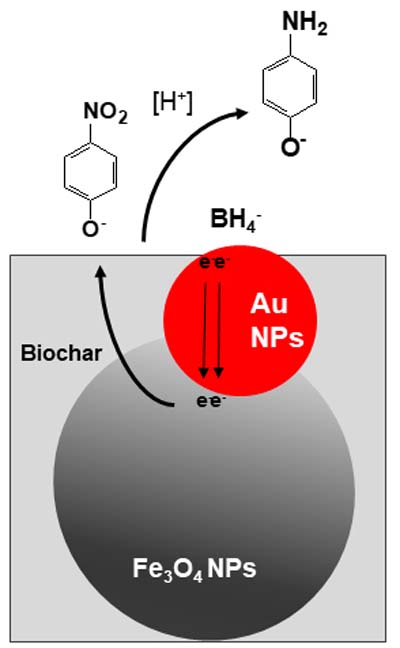
Synergistic effect between Fe3O4 NPs and AuNPs supported on biochar is demonstrated in the p-nitrophenol reduction.
https://dx.doi.org/10.21577/0103-5053.20210056
Online version ISSN 1678-4790 Printed version ISSN 0103-5053
Journal of the Brazilian Chemical Society
JBCS Editorial and Publishing Office
University of Campinas - UNICAMP
13083-970 Campinas-SP, Brazil
Free access










